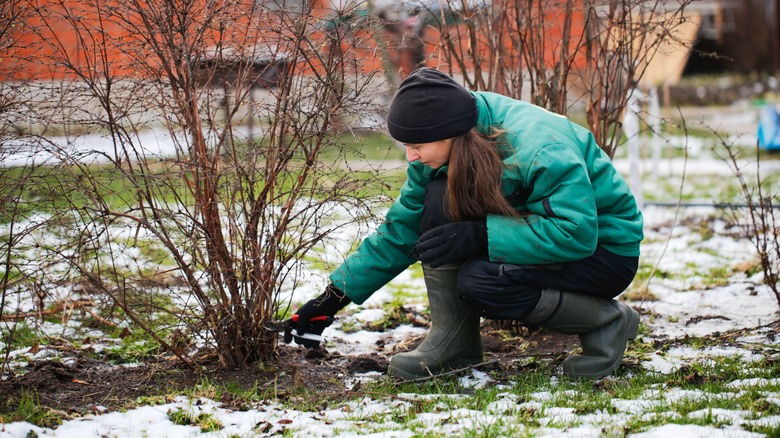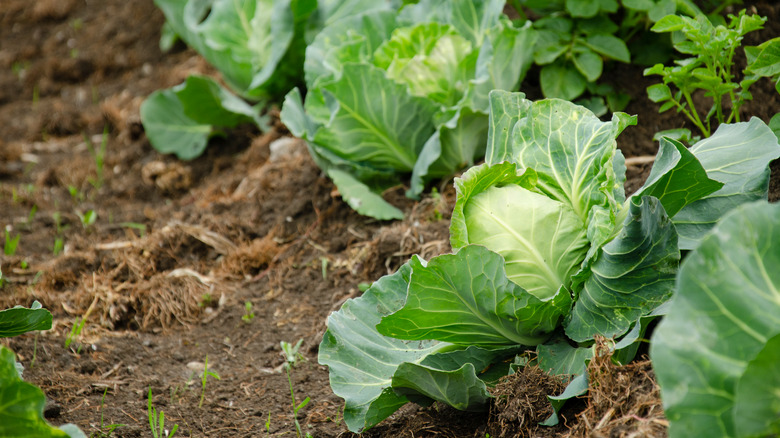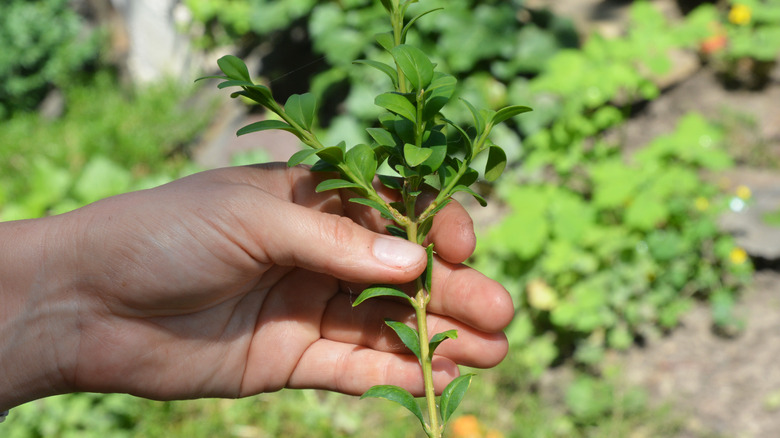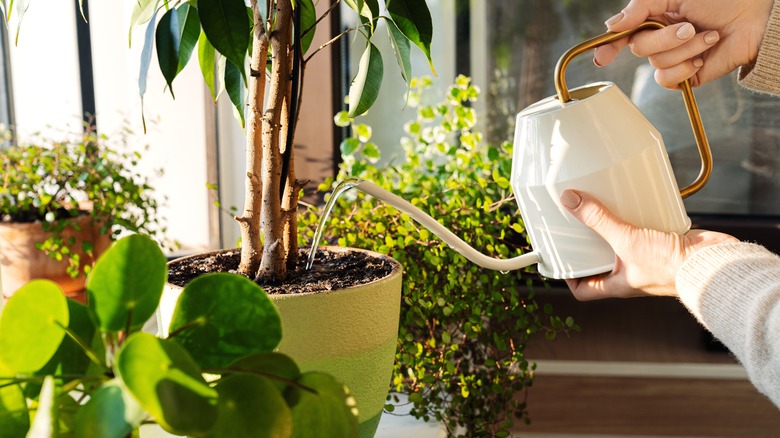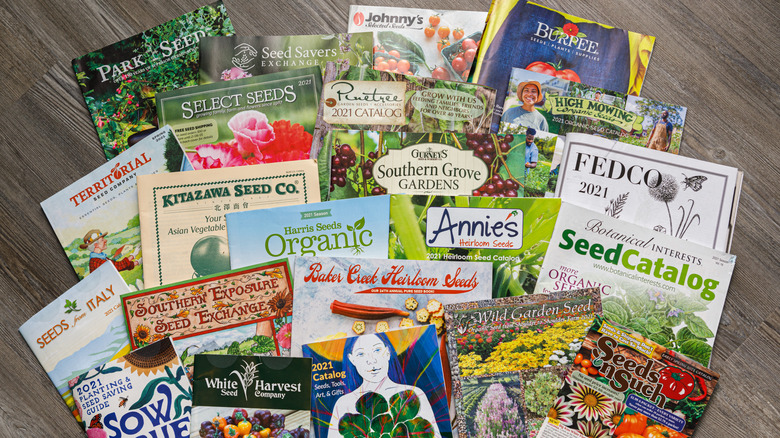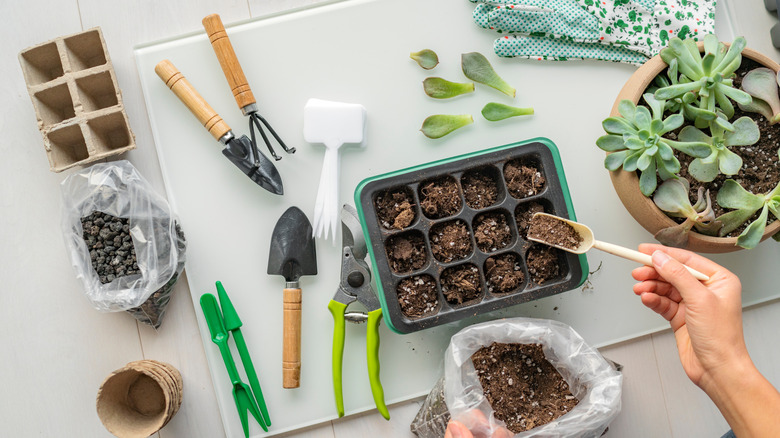How To Keep Your Green Thumb Active In The Winter, According To A Gardening Expert
From early spring through the late summer harvest, many people find gardening to be an enjoyable way to spend time. Even cleaning up the landscaping throughout the fall keeps us busy, making it an almost year-round experience. According to the Cleveland Clinic, gardening can improve health by slowing down the onset of osteoporosis, boosting our brains and mental well-being, and ensuring we get our daily dose of Vitamin D and exercise.
With all of the good that gardening can do for you, you probably don't want to give it up when winter arrives. However, with a bit of guidance on the tasks you can take on during the colder months, you may not have to do so. Tim Flood, Head Horticulturist at Nature Hills Nursery, America's largest online plant nursery, shares how to keep your green thumb busy in an exclusive interview with House Digest. How many of these activities can you engage in this winter after your vegetable or flower garden is done growing for the season?
Extend your outdoor season
Who says gardening ends at the first nip of cool weather? Tim Flood says, "Learn to extend your outdoor season – both early spring and later into fall!" Take time to talk to an expert at a local garden center or do research online to learn a bit about your area's late season growing opportunities. "Depending upon where you live, you can plant cool-season veggies and flowering plants that love the cooler weather," Flood suggests. "Rip out those tired annuals and plant some pansies, snapdragons, and flowering kale – and in the veggie garden, plant late crops of the cabbage family and your favorite salad greens."
You may need to take a few extra steps and be creative in this process, but you can still produce a beautiful and fruitful garden for a longer period of time in most areas. Per Flood, "Add a simple cold frame against the sunny side of your house and get some greens growing there too during the winter."
Use branches to decorate your home
You can bring your passion for gardening right into your home by using your pruned cuttings to create beauty throughout your interior. Tim Flood states, "Harvest natural cuttings from your yard like ornamental grass, flower heads, and seed heads for fall. Don't forget evergreens like pine and fir along with broadleaved evergreens like boxwood and holly branches to use in urns, make wreaths, or make decor for the mantle, not only for the holidays but for winter." You may already be doing some of the trimming of these plants to prep them for winter. Flood adds that curly willow and red and yellow twigged dogwood branches are particularly great as recycled cuttings to use decoratively inside your home.
Perhaps you've already completed your yard maintenance and don't have any trimmings to bring indoors. In that case, Flood says, "Add some container-grown evergreens for winter interest." This isn't just a process to do in the dark and freezing months, it can be a fantastic way to brighten your home during early spring, too. "Closer to spring, cut some forsythia or flowering quince branches to force for your home," says Flood.
Get into the houseplant game
Outdoor gardening can be quite enjoyable and bringing your love of gardening into the home is the perfect way to keep your green thumb working. "Houseplants are all the rage. If you haven't joined in, what are you waiting for?" asks the expert. Some people may shy away from houseplants because they require much different care than outdoor gardens. Reassuringly, Tim Flood has some tips. "Try a couple of easy ones and be sure you place them in the right sun exposure. Be careful not to overwater them – especially during the shorter cloudy days of winter."
Don't overwhelm yourself in the process, and realize that caring for indoor plants has a bit of a learning curve even for seasoned gardeners. Flood offers a few more helpful strategies for being successful. "Even houseplants take a bit of a break putting out much new growth until the days begin to get longer. Start easy, start small until you get the hang of how they grow. Keep a mist bottle handy to keep up on the humidity. Before you know it, you could be an orchid expert."
When you're ready to get in the game, there are many types of orchids that make easy houseplants. Have fun exploring your options for delightful indoor growers.
Plan for the upcoming growing season
There are ways to continue working on your outdoor garden during the winter months, too, even when there's a foot of snow on the ground. Tim Flood recommends using this time wisely to contemplate and design next year's vegetable and herb garden. "The offseason is a great time to plan your new landscape or the renovation of an old one, or plan a new addition to your existing landscape."
Take stock of how your garden did last year, consider what you would like to accomplish in the coming year, and then hash out your plans. Flood suggests assessing which of your plants thrived in the garden and which didn't do nearly as well and you'd hoped. Once you feel clear and inspired by your plan, take action. "Get your seeds or plants ordered early before the best varieties are sold out," he warns. "Get them ordered to reserve the plants for your spring shipment." This is a fantastic way to get excited about your garden for next season and still be in the growing frame of mind even when it's cold out.
Start spring plants inside
In very cold climates where the growing season is short, you may usually rely on purchased seedlings to fill your garden. However, the warmth of your home and a bright spot by the window throughout winter can create the ideal place to start seeds indoors. So, why not make some changes this year? "Start growing some vegetables and flower seeds to later plant outside after the danger of frost has passed," Tim Flood advises.
Taking this step requires research on when and how to grow indoors, which is sometimes specific to where you live. Flood offers a few tips. "The mistake is to sometimes get the seedlings started a bit too soon, which can end up producing weak or leggy plants. Count back from the estimated last frost date to know when to start your seedlings." Of course, the Old Farmer's Almanac is the ultimate source for insight into when to expect the last frost of the season.
